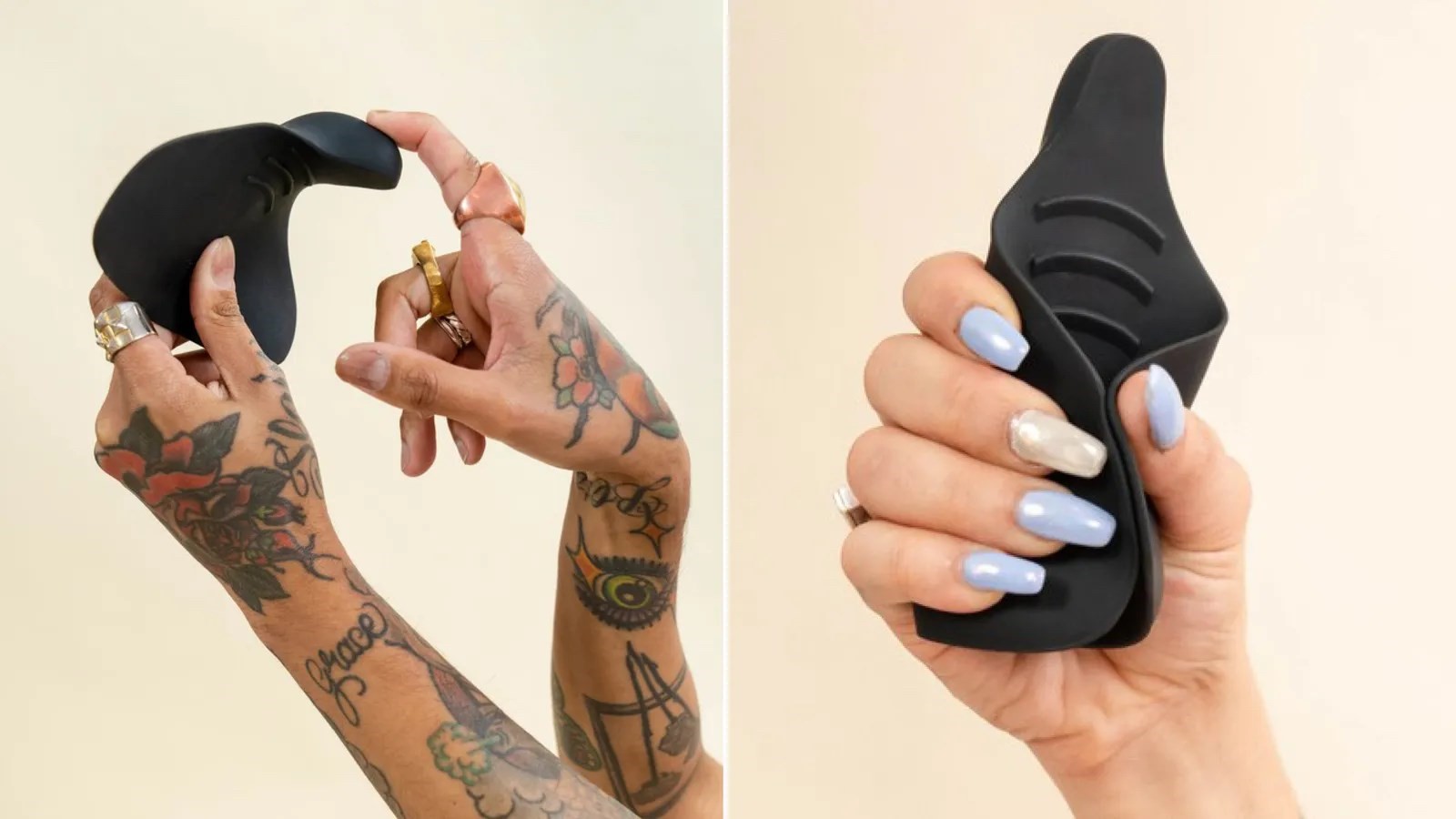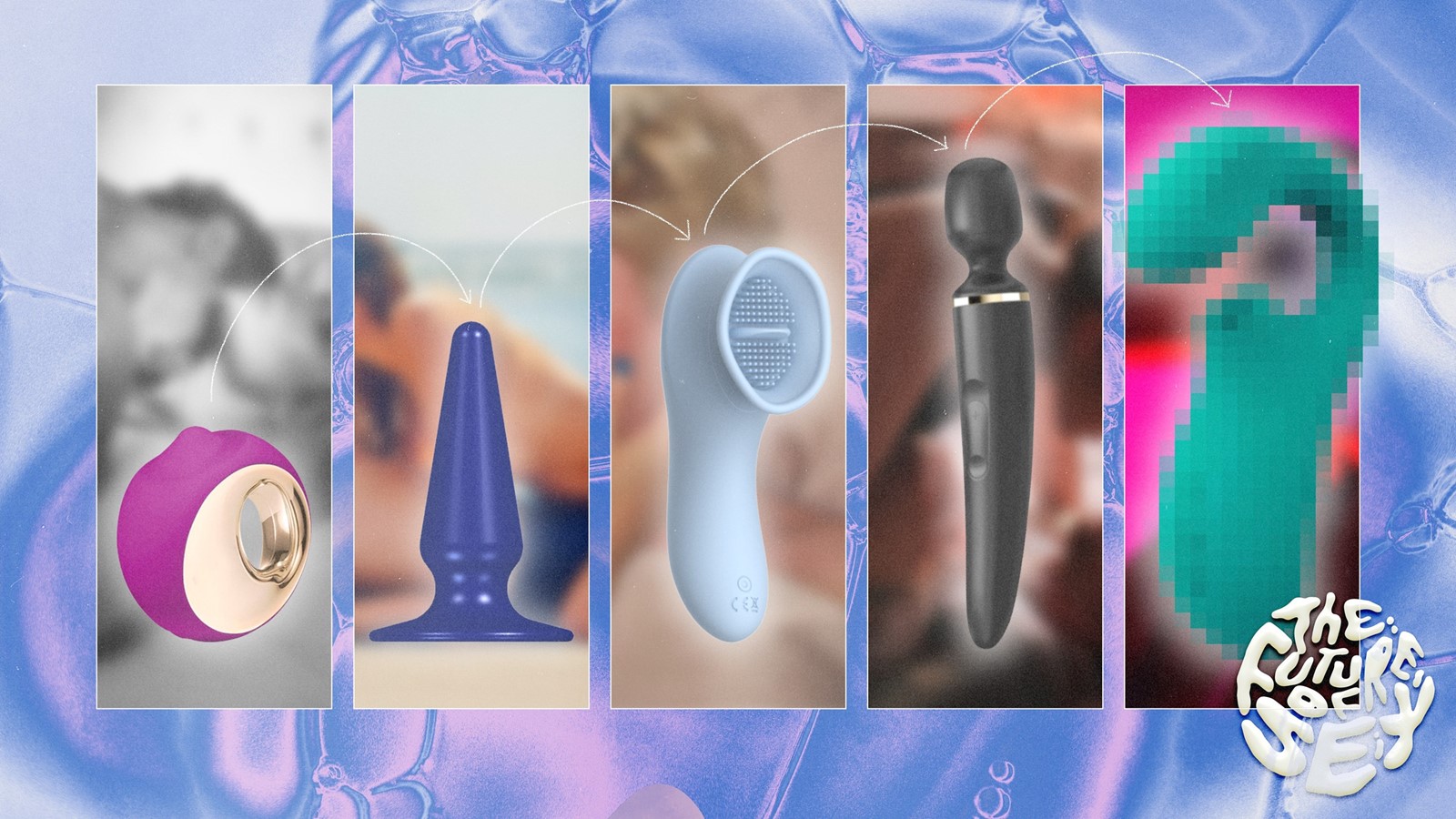From voice-controlled blow job machines to abstract, sting ray-shaped vibrators, a new wave of inclusive innovators are stretching the boundaries of sexual wellness
This article is part of our Future of Sex season – a series of features investigating the future of sex, relationships, dating, sex work and sex worker rights; tech; taboos; and the next socio-political sexual frontiers.
As mainstream society is still getting used to more novice (but admired) sex toys like bullets or masturbation eggs, Brian Sloan, the creator of the Autoblow, has invented a voice-controlled blow job machine. As well as giving its user the ability to command the device to “finish me”, the Autoblow AI+ features a downloadable blow job library, so you can enjoy a different BJ every time – varying speeds, pauses, and all. As the tagline goes, “For blow jobs, it’s the best!”
If you think this is eerily futuristic, you may be surprised to hear that Sloan created the original Autoblow 14 years ago. “As robots were becoming more of a fixture in human life in all ways, I had a very strong conviction that there was an opportunity to apply the latest advancements to sexual devices,” he says. As a matter of fact, the Autoblow AI+ is the fourth iteration of the machine, which, in simplistic terms, is a hands-free box containing a silicone “mouth sleeve” that applies pressure as it moves up and down your dick. The Autoblow’s next iteration will have adult video syncing, meaning your blow job machine will be able to move perfectly in sync with the action in a porn film.
A device like this might seem on the fringes of society – and it is – but there’s clearly demand for it. The Autoblow was crowdfunded into existence not once, but twice, racking up an impressive $950k, raised by over 3,000 supporters. In fact, the global sexual wellness market is estimated to reach $37.2 billion by 2023, an increase of over 11 million since 2017. “Sex toys are becoming more mainstream every year,” says Epiphora, a veteran sex toy reviewer and blogger. “Social media has pushed us in that direction, showing younger folks that sex toys can be fun, approachable, and even empowering.” As always, TikTok is leading the charge here, with videos about viral toys like the Rose and the WaterSlyde amassing millions of views on the platform.
Similarly helping the cause are the hordes of celebrities suddenly moving into the sexual wellness industry – and I’m not just talking about Goop. Lily Allen launched her own sex toy, Cara Delevigne is now the co-owner of a sex tech business, and, just last week, Frank Ocean dropped an XXXL cock ring (well, kind of – it’s purely decorative and costs, er, £27k). These public, sometimes high-profile, conversations about sex toys play a huge role in helping to reduce some of the stigma still tied to all aspects of the sex industry. “These celebrities are giving a new group of people permission to explore self-pleasure,” explains Suki Dunham, the CEO and founder of sex tech company OhMiBod, “and to help them understand that sexual wellness and overall wellness are tied together.”
The pandemic also had a major influence on this. During the height of the 2020 lockdown, when people were separated from their partners or literally banned from having casual sex, sales of sex toys skyrocketed. BuzzFeed even reported that, in April 2020, sales were up by 600 per cent compared to the previous year. Not only that, but attitudes appeared to shift, with 68 per cent of respondents to a May 2020 survey by sex toy company TENGA saying they’d continue to increase their sex toy use post-pandemic, while 21 per cent said their views on sex toys had become more positive. And this momentum hasn’t dwindled. Last year, wellness retailer Cult Beauty reported that searches for the most popular sex toys were still up by an average of 42 per cent compared to 2020, with demand for clit suction toys (like the Rose) increasing by an eye-watering 80 per cent.
People weren’t just searching for solo ways to get themselves off, either. Eyes increasingly turned to the sex tech industry, as buyers yearned for innovations that could help them connect with their partner, wherever in the world they happened to be. “We’ve been committed to the app-connected pleasure products space for a while now, but things took off like crazy when the pandemic hit,” says Dunham. “Buyers understand that intimacy works digitally.” OhMiBod specialises in app-connected pleasure products that can be controlled locally or remotely, and have the capabilities to sync with a partner’s toy or the rhythm of whatever music you’re listening to.
“We’ve been committed to the app-connected pleasure products space for a while now, but things took off like crazy when the pandemic hit. Buyers understand that intimacy works digitally” – Suki Dunham
Still, although the pandemic has been a catalyst for an increased interest in sex toys, the sex industry has been innovating, somewhat behind the scenes, for years – both in terms of technical advancements, but also when it comes to cultural shifts. Marginalised creators, for example – although still sorely underrepresented – have been breaking new ground by taking matters into their own hands, designing sex toys for people who’ve previously been excluded from the market, like those with disabilities, or gender non-conforming people.
Disability awareness consultant Andrew Gurza is one such creator. He and his sister Heather Morrison are the co-founders of Bump’n, a start-up creating sex toys for disabled people. “Historically, sex and disability have been considered taboo,” says Gurza. “The idea of disabled people having a sex life wasn’t even considered, so as a result, products for disabled people to enjoy pleasure weren’t considered.” When they surveyed the community, Gurza and Morrison found that 50 per cent of physically disabled people struggled to achieve sexual pleasure on their own, with 92 per cent of them saying they wanted a toy designed for them to attain this. “We realised that we could do something that would revolutionise the sex tech industry, but, more importantly, connect disabled people to their human right to pleasure,” Gurza explains.
The pair worked with industrial designer Judith Glover (whose PhD explored sex toy design) to design the first-ever device specifically designed for and by disabled people: the Bump’n Joystick. Slated for release in September, the gender-neutral, bendable Joystick is designed for those with hand limitations, and has a soft, “cuddly pillow” top and a base that can hold a variety of sleeves, dildos, wands, and vibrators. Bump’n is in the process of designing these, too, but, as Morrison previously told Mashable, many people already have toys that they hoped would work but didn’t, so the midsection will act as a holster to finally enable solo use of them. “We’ve worked with the disability community from the very beginning of this process,” Gurza adds, “ensuring that they can provide feedback on what does and doesn’t work for them to make the toy as accessible as possible.”
“To bring sex toys out of the shadows, it was important to make them techy, attractive, and a lifestyle product that you wouldn’t feel embarrassed for someone to stumble across” – Kelly Gordon
While Bump’n is currently the distinct trailblazer when it comes to sex tech for disabled people, other marginalised groups, including gender non-conforming people, are starting to welcome increased competition. And it’s not just established retailers launching gender-neutral toys, companies dedicated to trans, non-binary, and gender non-conforming people are springing up. Take, for example, enby, a Black/trans-owned marketplace established to cater specifically for the queer community, or Cute Little Fuckers, a trans-owned company that creates gender-inclusive monster-shaped sex toys (the latter hit headlines in 2019 after tripling its Kickstarter goal, raising over $35,000).
“As a non-binary person, it’s exciting to see not only more gender diverse folks represented in products within the sex toy industry, but also running the companies making the products, too,” says Natasha Marie, the head of communications at sexual health firm MysteryVibe. “Societal norms reinforce gender stereotypes about sex, pleasure, and anatomy, so that has been reflected in the traditional design approach of sex toys and vibrators. Now, as the social climate is slowly changing, marginalised demographics have a voice that is finally being heard and represented.”
MysteryVibe aimed to achieve this with its Crescendo, a gender-neutral vibrator that bends to suit “people of all orientations and identities”. The toy – which looks fairly dildo-esque, but with one flat side – intends to simulate a finger, and can bend into a ‘C’ shape for clitoral and G-spot stimulation, a ‘J’ shape to curve around the head of the penis, and many more, including into positions for partnered sex. It can also be controlled via the MysteryVibe app.
Sexual wellness store Wild Flower had a similar aim when creating its first non-binary-specific sex toy, Enby (not to be confused with the aforementioned marketplace) – a sting ray-shaped vibrator that can be humped, rubbed, tucked in a harness, or curled for stroking. “Enby was a mash-up of ideas to fill in where we saw the sex toy industry was lacking in representation,” explains CEO Amy Boyajian. “We had a close friend who was going through a physical transition, and commented that they would need to get all new toys for their changed body, which didn’t seem fair.”

These kinds of designs – which don’t resemble a human orifice – are also beginning to be adopted by creators of more mainstream toys. Hot Octopuss’ Pulse range, dubbed the “world’s first Guybrator”, is a sleek-looking James Bond-esque gadget that slots neatly around your penis and vibrates. It can be used as a hand-held stroker or a hands-free masturbator and boasts vibration patterns designed for edging sensations. It can also be used on a flaccid penis, as it allegedly delivers “high-amplitude oscillations” that can bring those with erectile dysfunction to orgasm, even without an erection. The name ‘Guybrator’ aside, Hot Octopuss has also started adopting more gender-neutral language, writing on its website that the Pulse is for “everyone with a penis”.
“[When we created Pulse], there was a real lack of any sex toys for penis owners,” says Kelly Gordon, the creative head at Hot Octopuss. “Unless you were looking for a fleshlight, there wasn’t much choice at all. To bring sex toys out of the shadows, it was important to make them techy, attractive, and a lifestyle product that you wouldn’t feel embarrassed for someone to stumble across.” Sex toys for men – and particularly straight men – have historically been shrouded in shame. As sex expert Nichi Hodgson previously told Dazed: “There’s a persistent belief in our society that ‘real’ men don’t need aids. If you don’t get off on your own, there must be something wrong with you sexually.”
Sloan believes this stigmatisation has also been enhanced by the “crude marketing” of the previous generation of male sex toys, which, he says, relied heavily on pornographic imagery. “In recent years, the stigma associated with male toys has improved – and that’s directly related to the fact that most newer male sex toys are high-tech motorised devices that aren’t connected in any way to pornography.” Still, he adds, the industry can’t ignore the fact that many men do “want to insert their penis into something that looks like a human orifice”, which sex toy companies (like the Autoblow) have been – and remain – happy to oblige. After all, Sloan adds, “one of the most popular forms of sex toys for women are dildos that resemble penises”.
“I’d love to see a world in which sex toys and masturbation are truly normalised, but we’re not there. It starts with individuals exploring sex toys” – Epiphora
Even with increasingly high-tech, more, shall we say, discreet toys available, the market for men’s sex toys is still much smaller than that for women. Nevertheless, Sloan says, competition is getting increasingly sophisticated. “People have entered the industry from successful careers in consulting, academics, research, and other types of entrepreneurship,” he explains. “Which has pushed all of us to develop better devices, faster. Additionally, the more high-tech devices there are, the more ways we all find to market and reach our audiences, growing the total adult products market for everyone.”
Smart sex toys are particularly on the rise, with brands like Kiiroo, WeVibe, and Lovense leading the teledildonics charge, with the latter’s Nora/Max series having a sync feature that enables the toys to react to each user’s movements during a long-distance sex session – meaning you can actually feel your partner, even though they might be on the other side of the world. Meanwhile, brands like Lioness are taking a more holistic approach to pleasure, creating a vibrator that enables you to visualise your arousal, learn from it, and ultimately make your orgasms more enjoyable. And who could forget the vibrating buttplug that can be controlled via strangers on Twitter?
But it’s not just the IRL sex toy market that’s set to grow: sex is coming to the metaverse, whether Mark Zuckerberg likes it or not. “It isn’t a leap for us to see some sort of place for OhMiBod in the metaverse,” Dunham tells me, recalling the brand’s 2008 appearance in the online game Second Life. “We worked with a programmer to develop a controller that you could connect to your OhMiBod via a cable to your computer. Then, someone – another avatar [in the game] – could control your vibe with permission.”
In the meantime, what do sex toy creators think is coming next? “I hope to see more toys that consider physical change, whether it’s via elective physical transition, or things like injuries, disabilities, ageing, or changing preferences,” says Boyajian. With this in mind, Wild Flower dropped two new sex toys last year, Ova, which accommodates those who struggle to grip, and Willow, for people who experience pain and discomfort.
Dunham shouts out Kiiroo – a collaborator of OhMiBod – who she says has developed “VR tech that allows toys to interact with VR porn”, as well as “some great tech that supports online camming performers”. For Epiphora, though, it’s not just about sex tech innovation. “The pursuit of pleasure, especially self-pleasure, is not always seen as valid,” she explains. “I’d love to see a world in which sex toys and masturbation are truly normalised, but we’re not there. It starts with individuals exploring sex toys – but, to create a cultural shift, we need a significant upheaval. Orgasms are but one small piece of sexual freedom.”

